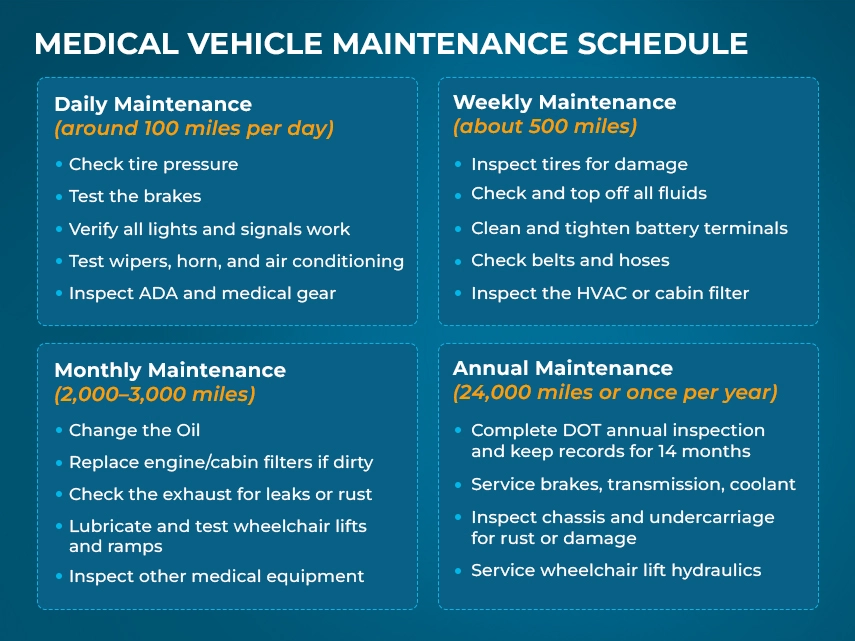Detailed Medical Vehicle Maintenance Schedule: Service Your NEMT Fleet Like A Pro

Good fleet maintenance is one of the major factors that separates medical transportation providers that are always there when they are needed and those who end up making last-minute cancellations, jeopardizing the well-being of their customers. Today, we attempt to draft a structured maintenance schedule that, if followed to a T, could ensure smooth operations and protect medical fleet operators from surprise breakdowns.
Contents:
- Important Caveats for Medical Transportation Fleet Maintenance
- Daily Maintenance (around 100 miles per day)
- Weekly Maintenance (about 500 miles)
- Monthly Maintenance (2,000–3,000 miles)
- Quarterly Maintenance (6,000–7,500 miles)
- Annual Maintenance (24,000 miles or once per year)
- Seasonal Fleet Maintenance in NEMT
- Emergency Maintenance Plan in Medical Transportation
- Tires: Rotation and Replacement Rules
- 12-Volt Battery Care
- Electric Vehicles Maintenance Adjustments
- Don't Wait for Breakdowns. Get Ahead of Them
Important Caveats for Medical Transportation Fleet Maintenance
In general, it is recommended to always follow the manufacturer’s guidelines while servicing your vehicles and maintaining detailed service records. But since medical vehicles work harder than personal cars, they need to be serviced more often. The schedule below is built for a typical NEMT fleet that runs about 100 miles a day in stop-and-go traffic, with plenty of idling and frequent use of ADA equipment.
NOTE: Accurate records protect you during audits and keep your vehicles compliant. Each service should be accompanied by the date, mileage, and the person responsible. To make tracking easier, many fleets use RouteGenie medical transportation software to log and schedule maintenance automatically.
Daily Maintenance (around 100 miles per day)
Start and end each shift with a quick look over the medical vehicle and complete a DVIR inspection:
- Measure tire pressure with a gauge and adjust if needed.
- IMPORTANT: Test the brakes. The pedal should feel firm and quiet.
- Make sure all lights work, including headlights, brake lights, and flashers.
- Test wipers, horn, and air conditioning.
- Do a quick test run of all ADA and medical gear, such as lifts, ramps, securements, and oxygen systems.
- Sanitize high-touch areas like handles, belts, and seats.
- Keep an eye out for leaks, dents, puddles, or warning lights. DO NOT ignore dashboard alerts and investigate them immediately.
Weekly Maintenance (about 500 miles)
This maintenance interval is for taking care of small issues identified in daily driver reports before they become major repairs.
- Inspect the tires and tread more carefully: look for any bumps, damage, and uneven wear.
- Verify fluid levels and top off if necessary: oil, coolant, brake fluid, and washer fluid.
- Clean and tighten battery terminals.
- Check belts and hoses for cracks or wear.
- Inspect the HVAC or cabin filter and replace it if dirty.
For more detailed guidance and maintenance techniques, see RouteGenie’s “Top 10 Tips for NEMT Fleet Maintenance”.
Monthly Maintenance (2,000–3,000 miles)
Monthly service procedures are for more substantial maintenance:
Oil changes depend on the type of oil used:
- Conventional oil: every 3,000 miles or once a month.
- Synthetic blend: check regularly and change every 5,000–7,500 miles.
- Full synthetic: usually 7,500 miles or longer, following the manufacturer’s limits.
Additionally:
- Replace engine and cabin filters if dirty.
- Check the exhaust for leaks or rust.
- Lubricate and test wheelchair lifts and ramps.
- Inspect other ADA and medical equipment for safe and compliant operation.
Quarterly Maintenance (6,000–7,500 miles)
Many private vehicles cover this distance in a year, but NEMT vans can cover 7,500 miles and more in just three months, so pay extra attention to the quarterly checks:
- Change oil and filter if using synthetic oil and not done earlier.
- Rotate tires for even wear.
- Perform wheel alignment if you notice uneven tire wear, if the steering wheel is off-center, or the car pulls to one side while driving.
- Inspect the brakes, including pads, rotors, lines, and parking brake.
- Test the coolant for proper freeze protection.
- Check suspension and steering components.
- Load-test ADA lifts and securements under passenger weight.
Annual Maintenance (24,000 miles or once per year)
This is the most crucial part of the maintenance protocol. If you do not have an in-house team of mechanics, it is advisable to visit a dealership or professional auto show.
- If your vehicles qualify as FMCSA-regulated CMVs, complete the DOT annual inspection and retain the report for at least fourteen months.
- Flush and replace brake fluid; replace pads and rotors if needed.
- Check and service transmission fluid.
- Flush coolant every two to three years, but inspect it yearly.
- Examine the chassis and undercarriage for rust or cracks.
- Service wheelchair lift hydraulics, fluid, and seals.
- Replace spark plugs: copper at about 30,000 miles, platinum or iridium between 60,000 and 100,000.
- Replace worn belts and hoses.
- Complete a wheel alignment
- Review the total cost of ownership of the medical van and consider retiring it
Seasonal Fleet Maintenance in NEMT
This maintenance section strongly depends on the geography of your operation:
Winter prep: Crucial if you operate in a cold climate:
- Mount winter tires or use all-weather tires (certified with the Mountain Snowflake symbol)
- Test the heater.
- Swap in winter wiper blades and winter washer fluid.
- Load-test the 12-volt battery.
- Check antifreeze strength.
- Apply rust protection to the undercarriage in areas that use road salt.
- Equip the vehicle with winter gear.
Summer prep: Cannot be skipped if you expect a hot summer:
- Switch to summer tires and adjust pressures for heat.
- Test and recharge the air conditioner if necessary.
- Inspect the radiator, hoses, and cooling fans.
- Replace worn wiper blades.
Emergency Maintenance Plan in Medical Transportation
Even the best, well-maintained medical fleets comprised of new medical vans will experience breakdowns. When that happens:
- Keep roadside assistance contracts current and verify response times.
- Maintain at least one backup vehicle.
- Notify dispatch, passengers, and providers immediately if an issue occurs.
- Log every incident for insurance and compliance.
- Review what happened afterward to prevent a repeat occurrence.
Tires: Rotation and Replacement Rules
- Replace tires every 25,000–50,000 miles depending on brand, load, and driving conditions.
- Change any tire that’s been in use for six years, even if the tread looks fine.
- Replace any tire that is 10 years from the manufacturer’s date
- Rotate tires every 6,000–8,000 miles.
- Replace when tread depth is below:
- 4/32 inch for rain
- 6/32 inch for snow (or follow local rules)
- 2/32 inch minimum legal limit
12-Volt Battery Care
- Replace the battery every three to five years, or sooner if load tests fail.
- Do a load test each year after the third.
- Monitor more closely in extreme heat or cold, or if the vehicle has heavy electrical equipment.
- Keep terminals clean.
- Avoid long periods of inactivity to prevent corrosion and discharge.
Electric Vehicles Maintenance Adjustments
- Electric vehicles do not need regular oil changes.
- Brake pads last longer thanks to regenerative braking, but brake fluid still needs regular service.
- Expect faster tire wear due to extra vehicle weight.
- Inspect the battery cooling system and charging setup regularly.
- Check the State of Health (SoH) of the high-voltage battery using diagnostic tools to track range and degradation.
- Pay extra attention to the 12-Volt battery
Don't Wait for Breakdowns. Get Ahead of Them
A well-designed and strictly followed maintenance schedule does more than keep NEMT vehicles on the road. It protects passengers, drivers, and the company’s reputation. For NEMT fleets, reliability isn’t optional; it’s the backbone of compliance and the guarantee that NEMT passengers reach their vital healthcare appointments. The more consistently you follow this plan, the fewer surprises you face in daily operations.
Many medical transportation operators now use tools like RouteGenie to track mileage, log inspections, and schedule service reminders automatically. Whether your fleet has two vehicles or two hundred, staying organized is what keeps you moving and compliant. A clean record, a healthy fleet, and fewer emergency trip cancellations are the best signs that your maintenance plan is working.
About the author

Serhii Taborovskyi is the creator and author of the Automotive Territory YouTube Channel, with 300,000 subscribers and counting. He is an avid automotive enthusiast and a fan of any and all motorized vehicles. Serhii is a visiting author at RouteGenie, sharing his expertise for the benefit of the NEMT community.
The author assumes no responsibility or liability for any errors or omissions in the content of this site. The information contained in this site is provided on an "as is" basis with no guarantees of completeness, accuracy, usefulness or timeliness.